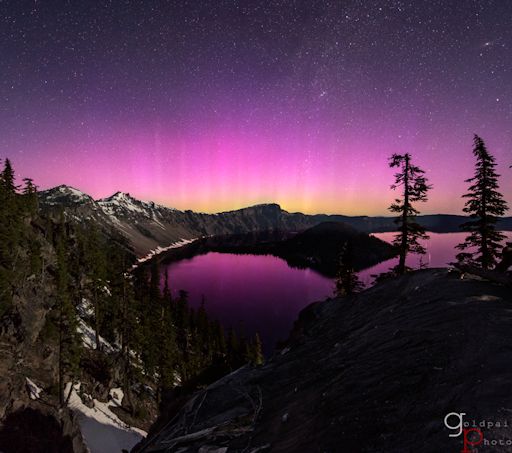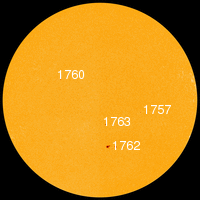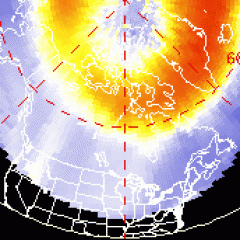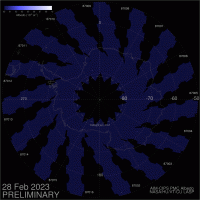CHANCE OF STORMS: NOAA forecasters estimate a 50% chance of polar geomagnetic storms on June 2nd as a high-speed (700 km/s) solar wind stream buffets Earth's magnetic field. The warning comes on the heels of a lengthy G2-class geomagnetic storm on May 31-June 1 sparked by the arrival of an interplanetary shock wave. The source of the shock is unknown. Current speculation focuses on a corotating interaction region (CIR)--that is, a shock-like transition zone between high- and low-speed solar wind streams. Whatever it was, the impact ignited some beautiful auroras, described below. Aurora alerts: text, voice.
AURORAS IN THE USA: On June 1st, Northern Lights spilled across the Canadian border into more than a dozen US states, turning the sky purple and green as far south as Colorado and Nebraska. Subscribers to the Space Weather Alert System (text, voice) knew the storm was coming, but others were surprised:
"Last night, I drove to Crater Lake National Park to photograph the Milky Way rising above the rim," reports Oregon photographer Brad Goldpaint. "I was staring upward towards a clear night sky when suddenly, without much warning, the aurora borealis began erupting in front of me." (continued below)
"With adrenaline pumping, I raced to the edge of the caldera, set up a time-lapse sequence, and watched northern lights dance until sunrise," he continues. "The moon rose around 2am and blanketed the surrounding landscape with a faint glow, adding depth and texture to the shot."
High-latitude sky watchers should remain alert for auroras tonight as Earth's magnetic field continues to reverberate from the impact. NOAA forecasters estimate a 40% chance of polar geomagnetic storms on June 1st. Aurora alerts: text, voice.

![]()
Solar wind
speed: 743.4 km/sec
density: 1.4 protons/cm3
explanation | more data
Updated: Today at 1647 UT
![]()
X-ray Solar Flares
6-hr max: B7 1027 UT Jun02
24-hr: C1 0521 UT Jun02
explanation | more data
Updated: Today at: 1600 UT
![]()
![]()
![]()
Daily Sun: 02 Jun 13
![]()
![]()
None of these magnetically-simple sunspots poses a threat for strong solar flares. Credit: SDO/HMI
![]()
![]()
![]()
Sunspot number: 60
What is the sunspot number?
Updated 01 Jun 2013
Spotless Days
Current Stretch: 0 days
2013 total: 0 days (0%)
2012 total: 0 days (0%)
2011 total: 2 days (<1%)
2010 total: 51 days (14%)
2009 total: 260 days (71%)
Since 2004: 821 days
Typical Solar Min: 486 days
Update 01 Jun 2013
The Radio Sun
10.7 cm flux: 104 sfu
explanation | more data
Updated 31 May 2013
![]()
![]()
![]()
Current Auroral Oval:
![]()
![]()
Switch to: Europe, USA, New Zealand, Antarctica
Credit: NOAA/POES
![]()
![]()
![]()
Planetary K-index
Now: Kp= 3 quiet
24-hr max: Kp= 5 storm
explanation | more data
![]()
Interplanetary Mag. Field
Btotal: 4.4 nT
Bz: 1.1 nT north
explanation | more data
Updated: Today at 1647 UT
![]()
![]()
![]()
Coronal Holes: 01 Jun 13
![]()
![]()
Solar wind flowing from this coronal hole should hit Earth's magnetic field on June 3-4. Credit: SDO/AIA.
![]()
![]()
NEW: Spaceweather.com is now posting daily satellite images of noctilucent clouds (NLCs), which hover over Earth's poles at the edge of space. The data come from NASA's AIM spacecraft. The north polar "daisy" pictured below is a composite of near-realtime images from AIM assembled by researchers at the University of Colorado's Laboratory for Atmospheric and Space Physics (LASP).
![]() Noctilucent Clouds
Noctilucent Clouds
![]()
![]()
![]()
Switch view: Europe, USA, Asia, Polar
![]()
Updated at: 06-01-2013 10:55:03






